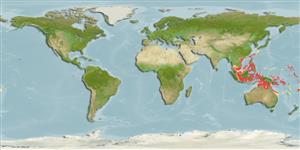>
Kurtiformes (Nurseryfishes, cardinalfishes.) >
Apogonidae (Cardinalfishes) > Apogoninae
Etymology: Rhabdamia: Greek, rhabdos = stick + Greek, amia = a kind of shark (Ref. 45335); spilota: Name from Greek 'spilota' meaning spot, referring to the distinctive spot above the pectoral fin..
Environment: milieu / climate zone / depth range / distribution range
Ecología
marino asociado a arrecife; rango de profundidad 20 - 55 m (Ref. 11894). Tropical
Indo-West Pacific.
Tamaño / Peso / Age
Maturity: Lm ? range ? - ? cm
Max length : 6.0 cm TL macho / no sexado; (Ref. 48635)
Espinas dorsales (total): 7; Radios blandos dorsales (total): 9; Espinas anales 2; Radios blandos anales: 12; Vértebra: 24. This species is distinguished by having D VI-I,9; A II,12; pectoral rays 13; total gill rakers on first arch 7+22; preopercular margin and ridge finely smooth; body very slender, depth 3.7-3.8 in SL; body semi transparent, whitish in life with 3-4 small dark spots midlaterally on operculum and above basal part of pectoral fin (Ref. 11894).
Swims in tight pairs (Ref. 48635); observed to occur in large aggregation around rocky outcrops with gorgonian fans and crinoids on steep slopes. Swims actively during the day above isolated coral heads to feed on zooplankton (Ref. 48635).
Life cycle and mating behavior
Madurez | Reproducción | Puesta | Huevos | Fecundidad | Larva
Distinct pairing during courtship and spawning (Ref. 205).
Yoshida, T., K. Mabuchi and H. Motomura, 2018. Rhabdamia novaluna, a new species of cardinalfish (Perciformes: Apogonidae) from the western Pacific Ocean, with comments on the synonymy of Rhabdamia gracilis. Ichthyol. Res. 66(1):129-139.
[First published online, pp. 1-11, 26 Oct. 2018; volume, issue and pages added on 17 Feb. 2019.] (Ref. 129520)
IUCN Red List Status (Ref. 130435)
Threat to humans
Harmless
Human uses
Más información
ReferenciasAcuiculturaPerfil de acuiculturaRazasGenéticaElectrophoresesheritabilidadEnfermedadesProcesamientoNutrientsMass conversion
ColaboradoresImágenesStamps, Coins Misc.SonidosCiguateraVelocidadTipo de nataciónSuperficie branquialOtolitosCerebrosVisión
Herramientas
Special reports
Download XML
Fuentes de Internet
Estimates based on models
Phylogenetic diversity index (Ref.
82804): PD
50 = 0.5156 [Uniqueness, from 0.5 = low to 2.0 = high].
Bayesian length-weight: a=0.01122 (0.00528 - 0.02384), b=3.10 (2.92 - 3.28), in cm total length, based on LWR estimates for this (Sub)family-body shape (Ref.
93245).
Nivel trófico (Ref.
69278): 3.4 ±0.45 se; based on food items.
Resiliencia (Ref.
120179): Alto, población duplicada en un tiempo mínimo inferior a 15 meses (Preliminary K or Fecundity.).
Fishing Vulnerability (Ref.
59153): Low vulnerability (10 of 100).
